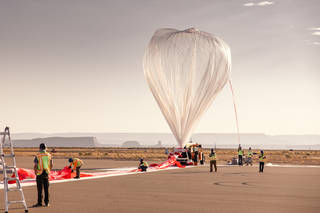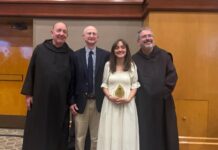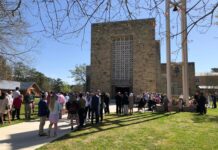
HARTSELLE, Ala. – A team of four students from Hartselle Junior High School (HJHS) were among 60 winners nationwide in the Future Engineers NASA TechRise Competition. “The Climate Crew” team is now preparing for the next phase, an experiment that will take flight a high-altitude balloon this summer.
In its second year, TechRise is a STEM competition open to grades 6-12 and offers the opportunity for hands-on STEM activities and projects. Students are given the chance to test their ideas about space exploration.
“The Future Engineers NASA TechRise Competition is a nationwide competition open to all public, private and charter schools in the United States and U.S. Territories,” explained HJHS and Hartselle High School Robotics Competition Coach Cheyenne Moses. “It was open to students grades 6-12. The winning teams will receive funding to build their experiment and meet with engineers weekly to help guide and mentor them. Their experiment will be launched over the summer in a high-altitude balloon where it will float at approximately 70,000 feet for at least four hours.”
The members of The Climate Crew are Addison Faulk, Lyla Crouch, Chloe Cutshall and Claire Joseph. Their team was the only winning team in the state of Alabama.
Moses continued, “They submitted ‘The Climate Cube.’ Their project has sensors and cameras on five sides. Some of the sensors they are including are CO2, SO2, temperature and humidity. They also plan to incorporate a regular camera and thermal camera. They believe that all of this data can be used together to view acid rain patterns and determine some of the contributing factors. They hope their data can be used to help alleviate the impact of acid rain.”
The team described its project as “a cube made out of plexiglass and steel that contains a CO2 sensor, SO2 sensor, distance sensor, a regular camera, thermal camera, thermometer and a microcontroller. On each face of the cube is a different data collector. Our main motive towards our experiment is climate change prevention. Climate change has largely affected our environment, and we believe stopping this should be everyone’s main priority.
“During our experiment we will be studying the C02 levels throughout the atmosphere. Our hypothesis is that as we go up higher into the atmosphere, the C02 levels will decrease because the farther away from Earth’s surface we get, the less the air is affected by pollutants. We believe this because C02 doesn’t break down until about 80 kilometers from Earth’s surface, meaning that the atmosphere is only affected by Earth’s pollutants up to 80 kilometers.
“Our next component to The Climate Cube is acid rain research. When S02 and other components are released into the air, acid rain is produced, meaning that the more S02 in the air, the more acid rain will occur. This knowledge will be used to predict when acid rain will take place. We can compare the other weather readings from days acid rain was produced and determine the average percentage of S02 needed in the atmosphere.
“Using our different thermometers, we will also research how heat affects the atmosphere. We know that as the altitude increases, the amount of gas molecules in the air decreases, which would lead to less heat, making the atmosphere much colder than it is on Earth.”
With the goal of engaging students for a future in technology, engineering, science and mathematics, TechRise created this year’s challenge to create a science or technology experiment that could be tested in a high-altitude balloon sponsored by NASA. The use of high-altitude balloons in experimentation has led to many discoveries over the past years that have altered the understanding of our planet, the solar system and even the universe.
“NASA’s missions of tomorrow are sparked by the accomplishments of the Artemis Generation today in classrooms across America,” said NASA Administrator Bill Nelson. “Through opportunities like the TechRise Student Challenge, young people are deepening their passion in science and technology, preparing to be the future innovators and pioneers who help humanity soar to new heights and unlock more secrets of the universe.”
Among this year’s 60 winning proposals were topics ranging from the evaluation of the effects of climate change, supporting human health during long space missions and protecting people and materials against radiation.
The students’ experiments will be tested on one of two balloon flights. One will be through Aerostar of Sioux Falls, South Dakota, and the other will be World View based in Tuscan, Arizona. The balloon will rise to approximately 70,000 feet and float for a minimum of four hours. In the stratosphere, the experiments, or payloads, will gather data unique to the thermal and atmospheric conditions of that altitude and also the topographic features below.
“I am extremely proud of these students. They worked hard and spent every second of free time they had in class researching and perfecting the design they turned in,” said Moses. “Seeing my students’ hard work come to life and the excitement I know they will have is what excites me the most. They are absolutely fascinated by the idea of a balloon flying that high!”
Copyright 2023 Humble Roots, LLC. All Rights Reserved.


















